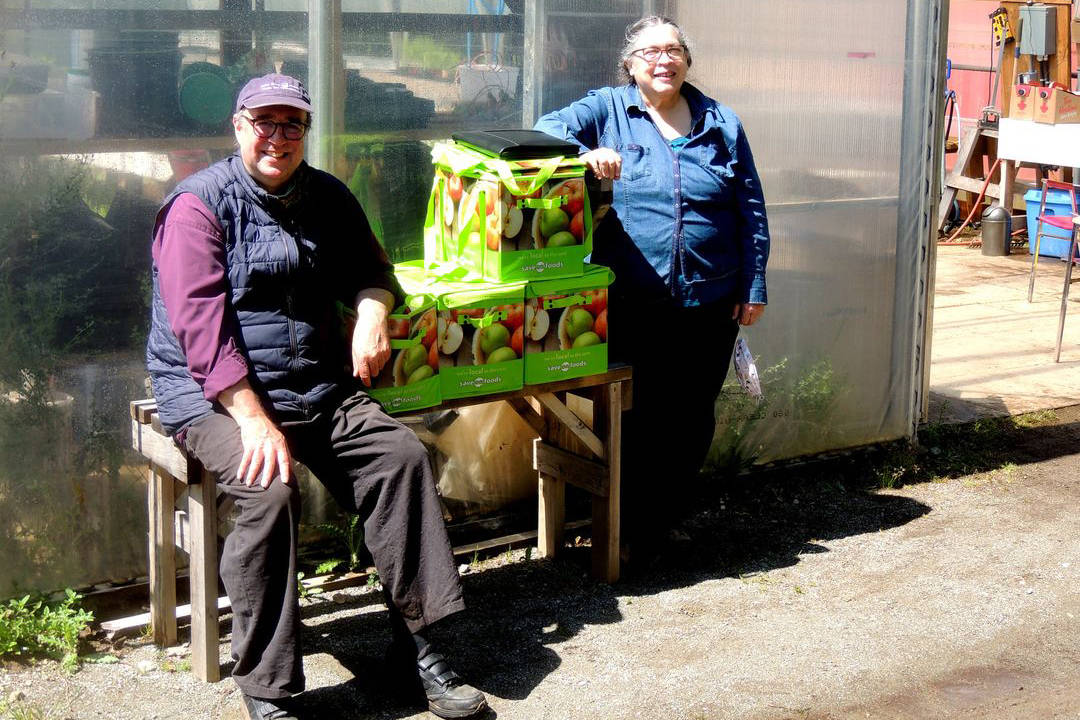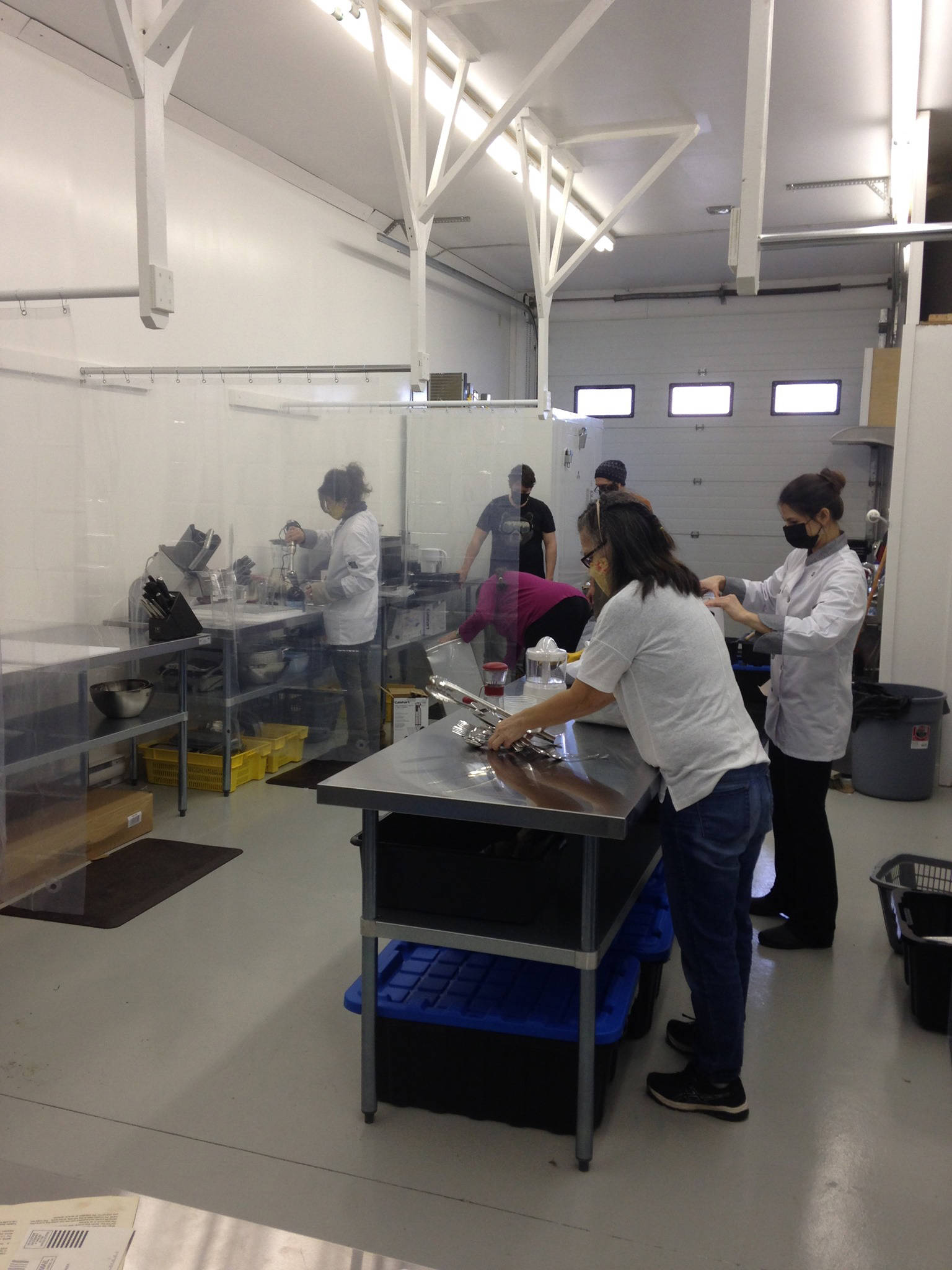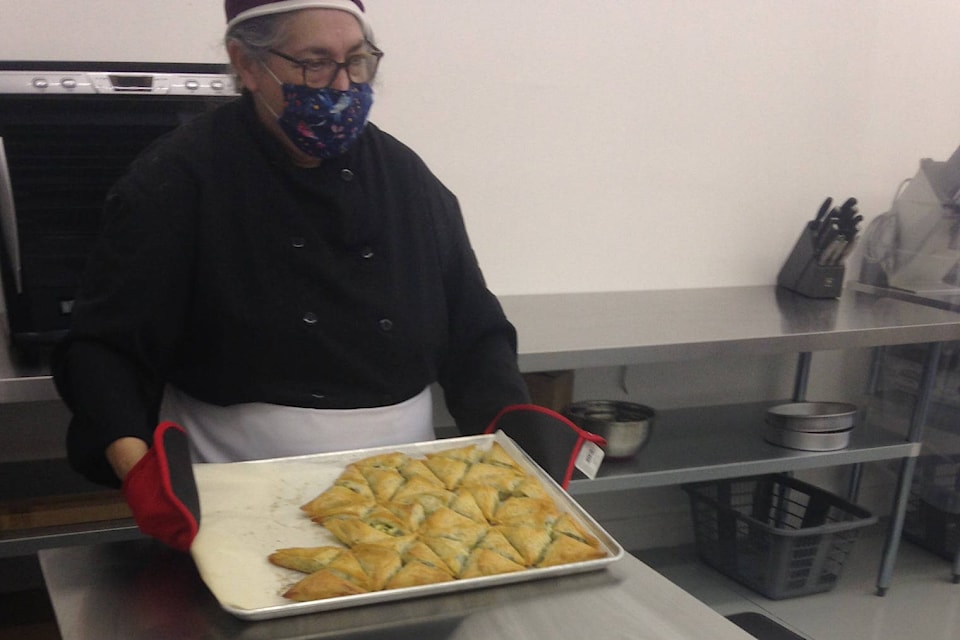This story is part of our Progress 2021 publication. You can read the special edition in its entirety on our website.
“When life gives you lemons, make lemonade.”
But what if life gives you English cucumbers? Or spinach? Or red grapes?
Students of the new Food Production and Processing course at the Port Alberni Shelter Farm looked to answer this question over a 15-week training program. The new program aims to reduce food waste, while also providing job skills for people in the community.
Guy Langlois, who oversees the Shelter Farm, says that the farm produces a lot of waste.
“That’s typical with a lot of farms,” said Langlois. “Some of the product is not marketable, because it’s bug-damaged or rodent-damaged. With this facility here, we can save the produce from the farm and make it into preserves—things like salsa, jams.”
The Shelter Farm is part of the Port Alberni Shelter Society group of services, one which provides food to the community while also providing job skills and experience to local students. The farm itself is located on Franklin River Road, but this year the Shelter Farm also added a food processing and production facility in a building on lower Third Avenue, which includes a small-scale commercial kitchen.
READ: Port Alberni Shelter Farm grows with the seasons
In addition to the food produced at the Shelter Farm, the Port Alberni Shelter Society receives truck loads of expired or nearly-expired food from different grocery stores. A lot of this is redistributed to the community, either through the shelter itself or through one of the other charitable agencies in town—for example, the Bread of Life, Salvation Army or Port Alberni Friendship Center. But because the food is perishable, it sometimes can’t be distributed fast enough.
“We collect tonnes—literal tonnes—of food every year,” said Langlois.
With the new Third Avenue facility, the Shelter Farm is focusing on creating value-added products, which gives food a longer shelf life.
“We’re trying to reduce the amount of waste,” said Langlois.
Earlier this year, the Shelter Society received a grant from the federal government to set up the commercial kitchen, as well as a three-month Food Production and Processing Program in partnership with North Island College. The 15-week program trained applicants to work in the processing facility, including a six-week unpaid work placement.
This is where Vivian Cruise came in. Cruise, who currently lives in Vancouver, has been cooking since she was five years old. Although she is retired from her career as a Red Seal chef, she still teaches cooking.
“I’m always up for something,” she said.
Cruise has experience as a teacher through Seaspan, teaching cooks about deckhand cuisine. When it comes to boating, crews can be at sea for weeks. Cooks need to be aware of what kind of food is on board and plan ahead, using ingredients more effectively so they can last longer.
Cruise built much of the Shelter Farm program around her cookbook, Ocean Plaits & Grizzly Bait, which is designed for deckhand cooks and filled with information about feeding crews on a boat.
“We literally invented the course,” laughed Cruise.
With excess potatoes, students sliced these and processed them into frozen stores that can be used by chefs in restaurants. Some of them were freeze-dried and some were turned into potato chips.
When the Shelter Farm received a truckload of grapes, the class made grape jam and pickled grapes. They cooked grapes into loaves of focaccia and cooked grape and melon soup.
Even when the class made paneer (an Indian soft cheese), the leftover whey from the lesson was used for making breads and soups. Nothing went to waste in the program.
“‘When life hands you lemons, make lemonade,’” Cruise quipped. “We made lots of lemonade–over and over again.”
The program had 10 graduates, most of which went on to pick up work experience either at the Shelter or at The Dock+ on Port Alberni’s waterfront.
Charli Martens-Carpenter was one of the program graduates, who is now training to become a kitchen manager at the Shelter kitchen. She originally joined the program because she was interested in learning how to create jams and preserves.
“It was a really rewarding experience,” she said. “It was pretty great to make a bunch of food and share it out with the community.”
Every Friday, the students cooked up lunches and took them down to the Shelter Farm on Franklin River Road. They also experimented with making “emergency stores” of freeze-dried food.
“All you do is open it up, add water and you have a meal,” said Cruise.
Cruise described the Food Production and Processing Program as an ongoing experiment—one that’s going well.
“I wanted to build within [students] possibilities,” she said. “I wanted them to be familiar with looking at things and knowing what they can create with it. ‘We have too much of this, what are we going to do?’ Well, now they have the capacity and some knowledge to make things.”
“We had a really good time,” she added. “And we’re saving groceries from being thrown in the garbage.”
Students in the program used the commercial kitchen at The Dock+ for the first week of classes so they could become familiar with the space and the equipment. After this, they moved into the kitchen on Third Avenue.
The new kitchen had six different stations, where students could work and stay socially distanced from one another.
“The intention of this facility is that it can eventually become a community resource,” said Langlois. “We’re not there yet.”
Langlois would eventually like to open a storefront and a distribution centre for people who are interested in purchasing local produce, eggs, milk and meat. The Shelter Farm currently offers a CSA (community supported agriculture) produce box that people can sign up for and get a weekly supply of vegetables, fruit, herbs and mushrooms. The box has 30 subscribers so far.
Langlois sees the Third Avenue facility becoming a food hub, acting as a partnership between farmers and consumers.
“We receive products from farmers and distribute them to the consumers,” he explained. “That means consumers can get food directly from local farmers, supporting the local economy.”
The Food Production and Processing program will be offered again in September. If you are interested in registering, contact Guy Langlois at guy_pashelter@shaw.ca.
RELATED: Port Alberni’s Shelter Farm offers second year of market gardener program


